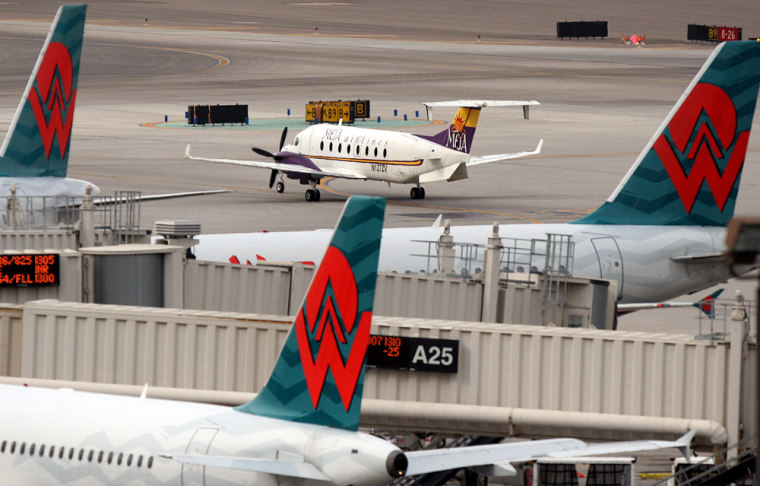At a time when the nation’s major airlines are being buffeted by skyrocketing fuel costs, heavy competition and bankruptcies, some regional carriers are posting growing profits and looking to expand.
Phoenix-based Mesa Air Group Inc. is one of the high-fliers. It plans to go to Hawaii early next year, adding planes for an interisland service that will compete with Hawaiian and Aloha Airlines. Also turning in impressive growth and profit numbers are Republic Airways Holdings and SkyWest Inc.
The regional airline sector is growing and profitable thanks to contracts with the major airlines — which guarantee minimum amounts of revenue and pay some costs — and because larger airlines are turning over smaller routes to concentrate on those with heavier traffic.
But it is the airline industry, so there are companies in serious trouble and the business remains risky — also because it is so dependent on the larger airlines.
Regional carriers usually fly between smaller destinations and major hubs under large airlines’ names, logos and ticketing. The large airlines guarantee revenue to the regional carriers, which don’t have the expensive union contracts and pension obligations of the major airlines.
“We have a good business model because to a degree we are like the fuelers or like Boeing (Co.),” said Mesa CEO Jonathan Ornstein. “They need our product and we’re cost effective.”
The regional airlines have deals with the major airlines which pay their fuel, landing and insurance costs, said Ray Neidl, an analyst with Calyon Securities. That pass-through cost structure buffers them from a lot of the costs that weigh down the larger airlines.
“They’re cash-flow machines, which is unusual in the airline industry,” Neidl said of the regional carriers.
A few regionals are struggling or have gone into bankruptcy, following the path of their big airline partners, but others, including Mesa, Indiana-based Republic and Utah-based SkyWest, have enjoyed growing profits and significant stock gains.
Mesa doubled its profit in the fiscal year that ended Sept. 30 to $56.9 million. SkyWest grew its third-quarter profits 41 percent to $56.9 million over last year’s and Republic’s third-quarter earnings were up 63 percent to $14 million.
The nation’s 74 regional airlines have doubled their passenger load in the past decade, according to the Regional Airline Association, an industry trade group. They’ve done it mainly by adding more flights and cities to feed the major carriers’ need for passengers and taking over routes the majors abandoned; with their smaller planes and lower costs, the regionals are able to service secondary markets where the major airlines lose money.
In the past two years, passengers have increased from 113 million to 134 million per year.
Phoenix-based Mesa is using its cash to grow in an unusual direction, starting a stand-alone airline without a major airline partner. Ornstein said the company has nearly $300 million in cash on hand and is on solid financial footing to expand.
Mesa plans to open an inter-island service in Hawaii on its own next year, using six 50-passenger planes for the new service. It hopes to wrest control of the island-hopping trade from the bigger carriers.
Ornstein says Hawaiian and Aloha have used those routes to prop up their money-losing mainland-to-Hawaii flights.
“Without the trans-Pacific operations we can operate very profitably,” Ornstein said.
But Mesa’s expansion plans are dwarfed by the growth of SkyWest.
Already one of the biggest regional air carriers with 9,100 employees and 226 planes, SkyWest paid $425 million to acquire regional carrier Atlantic Southeast Airlines from Delta Air Lines in September. The deal closed days before Delta filed for bankruptcy, adding 6,000 workers and 151 aircraft to SkyWest’s fleet.
SkyWest officials said they negotiated protections to hedge against Delta’s financial woes, and a bankruptcy judge in October approved Atlantic Southeast’s ongoing 15-year contract as a Delta Connection carrier.
“We have been nicely protected as we move through that process,” said Mike Kraupp, vice president of finance and assistant treasurer for SkyWest.
Still, analysts say that the sagging fortunes of the major airlines are a big risk for regional carriers.
Mesaba Aviation, under contract with Northwest Airlines Corp., filed for bankruptcy protection Oct. 13, with parent company MAIR Holdings Inc. citing “cash shortages and significant fleet changes and uncertainties imposed on it,” by sole customer Northwest Airlines as the root cause. Northwest filed for bankruptcy in September.
Another regional carrier that flies under Northwest’s banner, Memphis-based Pinnacle Airlines Corp., reported a $21.4 million quarterly loss on Nov. 1, mainly because of losses from the Mesaba and Northwest bankruptcies.
But other regional carriers point to differences between the businesses of Mesaba and Pinnacle and their own. Mesaba and Pinnacle lease their planes from Northwest, making them especially vulnerable to fleet or route reductions by Northwest.
They were also vulnerable because they fly only for Northwest, while carriers like Republic, Mesa and SkyWest fly for more than one major airline.
The ability to spread business over more than one major airline provides protection that should ensure survivability for the regional carriers, said SkyWest’s Kraupp.
“We feel like what we’d be able to do is move our assets to another player,” he said. “The flying public will still need to have service.”
